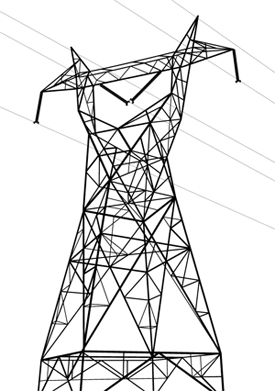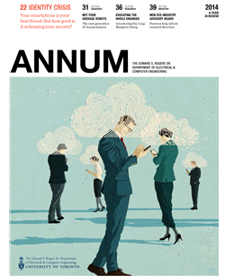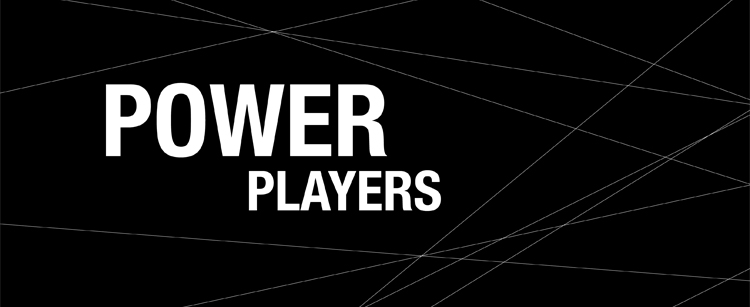Originally published in the 2014 issue of ANNUM Magazine.
A single unpruned tree was all it took.
On Aug. 14, 2003, one hot day in a hot summer, a power line sagged onto some branches in the small village of Walton Hills, Ohio. The resulting cascading failure throughout Ontario and the northeastern United States shut down power to more than 10 million people, becoming the second-most-widespread blackout in history and a major wake-up call for power generators and electric utilities operators around the world.
The grid has gotten a lot smarter since then, but there’s still plenty of room for improvement. “The building-up of intelligence on our network will continue to go forward forever—there will never be an end,” says Charles Esendal, manager of research, development and demonstration for Hydro One. “It’s not a destination, it’s a journey.”
Helping accelerate that journey are professors Reza Iravani, Zeb Tate and Josh Taylor. Each is collaborating with Hydro One on a project to make Hydro One’s network more robust for the 21st century, by improving power-system stability and monitoring, use of energy storage, and integration of distributed energy resources, including intermittent renewable generation such as wind and solar power.
 The three projects launched in 2014 and will run for two years under the guidance of a steering committee composed of Esendal and Birendra Singh from Hydro One, ECE Chair Professor Farid Najm, and professors Reza Iravani and Peter Lehn.
The three projects launched in 2014 and will run for two years under the guidance of a steering committee composed of Esendal and Birendra Singh from Hydro One, ECE Chair Professor Farid Najm, and professors Reza Iravani and Peter Lehn.
Islands in the Storm
The current grid’s interconnectivity, a strength when all runs smoothly, becomes a liability in adverse conditions—Americans witnessed this after Hurricane Sandy blasted the northeastern U.S. in October 2012, shutting down vast swaths of the system. As severe and unpredictable weather events increase in frequency, the ability to isolate and operate sections of the grid independently and sustainably is a high priority.
“If some event happens upstream in the system and you get disconnected, you become an electrical island,” says Professor Iravani, who has had much successful collaboration with Hydro One and its predecessor, Ontario Hydro, since 1991. “We should be able to operate these islands in order to provide resiliency to the system, so it doesn’t completely shut down—it should be self-sustaining.” Professor Iravani is validating methods for isolating and controlling subsections of the grid within the larger system, and integrating renewable energy sources into these microgrids. Others have experimentally demonstrated this kind of microgrid islanding, but nothing has been validated and implemented on a larger scale.
The good news: all the essential elements of islanded microgrids—distributed resources, loads, transmission and monitoring infrastructure—are already in place on Hydro One’s network. The challenge is to control them effectively, whether they’re functioning as part of the whole or on their own.
“The components are there, but the point is to provide enough intelligence, decision-making and control for that mode of operation,” says Professor Iravani. “All the components should be individually controlled, and all the controls should be coordinated to enable unified operation of the system. That’s what we’re aiming for.”
The Great Green Unknown
We all know fossil fuels aren’t cheap, clean or abundant—but what are we doing about it? Plenty, it turns out—the high market penetration of solar generation from individual consumers, and the uptick in electric vehicles in need of a charge are introducing unknowns into the grid on both the supply and demand sides.
“It is great to be able to say ‘Let’s use the sun’s rays or the wind to generate electricity,’ but it’s very transient in nature,” says Esendal. “You cannot predict the trend at all, and that is the worst thing that you can have on the grid. The system requires accurate anticipation and prediction to be able to plan and dispatch the electricity where the need is. Unfortunately that is a major challenge in integration of renewable generation.”
What if you could bottle up some of that wind or sunlight for later, and redistribute it when need is high? “The most basic constraint on the power system is that supply must equal demand,” says Professor Taylor. “Renewables make the supply random, but storage can make it controllable—the question is how best to do that.”
Conventional storage meant pumping water up a hill and releasing it, converting potential to kinetic energy to make electricity—though it sounds old-fashioned, the method is quite efficient, but expensive and geographically restrictive. Professor Taylor is looking at both batteries and flywheels for more flexible, distributed storage and is developing an algorithm to make smart decisions about optimal locations and conditions to either store or release energy.
Ready for Anything
When a line overheats due to excessive current, as in the great blackout of August 2003, the power transferred by that line needs to be redirected, and utilities operators need to “reposition” the system in order to maintain stability. “In 2003 they didn’t know the lines were out, so they didn’t know they needed to reposition the system,” says Professor Tate. Operators learned the hard way that accurate information is everything, and afterward deployed much more sophisticated monitoring methods.
Professor Tate is working on a project to use these smarter monitors, called synchrophasors, to detect faults in the grid and automate rapid responses. Synchrophasors sample and relay magnitude and phase data between 30 and 60times per second, a vast improvement on old sensors that are polled only once every two to three seconds. “This gives you a much better idea of how power is flowing immediately, so you can tell whether a line is disconnected or a generator is down,” he says. “Improving detection fosters efficiency—you don’t have to run the system as conservatively if you know you can react instantly.”
“There are a lot of challenges today—these are only a few issues that we have,” says Esendal. “It will take some time to validate all of these technologies, but we needed to start somewhere and I think University of Toronto is in a great position, not only from the expertise perspective, but also to be located just in our backyard—it’s a great advantage.”
If all goes according to plan, you’ll never know how these projects turn out—you’ll just be cozy during the next deluge of freezing rain, cool throughout the sweltering summer, and connected in the next flood, hurricane or hail storm. And soon August 2003 will be just another unbelievable anecdote of times long past.
 ANNUM Magazine is an annual publication from The Edward S. Rogers Sr. Department of Electrical & Computer Engineering.
ANNUM Magazine is an annual publication from The Edward S. Rogers Sr. Department of Electrical & Computer Engineering.





